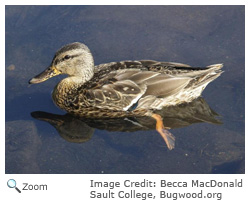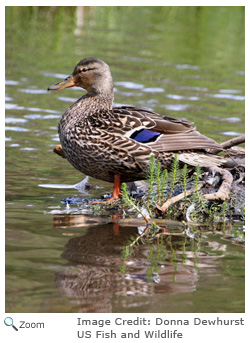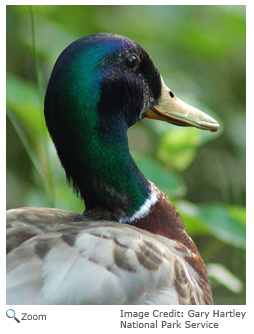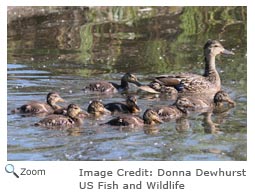Description
 The mallard is about 20-28 inches in length and has a wingspan of about three feet. It has a blue patch on the top side of its wings with a white line around it. The female mallard is mottled brown and tan with a white tail and an orange bill. The mallard is about 20-28 inches in length and has a wingspan of about three feet. It has a blue patch on the top side of its wings with a white line around it. The female mallard is mottled brown and tan with a white tail and an orange bill.
 The male mallard has a green head and neck with a white ring at the bottom of its neck. It has a brown chest, whitish-gray undersides, brown wings, and a yellow bill. The male mallard has a green head and neck with a white ring at the bottom of its neck. It has a brown chest, whitish-gray undersides, brown wings, and a yellow bill.
Range
 The mallard breeds in most of Canada and the United States. The mallard breeds in most of Canada and the United States.
It winters throughout the United States and south to Central America and the Caribbean. The mallard is also found in Europe and Asia.
Habitat
The mallard lives in marshes, lakes, swamps, rivers, streams and ponds.
Diet
 Most of the mallard's diet is made up of plants. It eats the seeds of grasses and sedges and the leaves, stems, and seeds of aquatic plants. It occasionally eats insects, crustaceans, and mollusks -- especially when it is young. It prefers to forage in water that is less than 16 inches deep so it can duck its head down and reach plants at the bottom. The mallard sometimes forages on farmland for grains like rice, corn, oats, wheat, and barley. Most of the mallard's diet is made up of plants. It eats the seeds of grasses and sedges and the leaves, stems, and seeds of aquatic plants. It occasionally eats insects, crustaceans, and mollusks -- especially when it is young. It prefers to forage in water that is less than 16 inches deep so it can duck its head down and reach plants at the bottom. The mallard sometimes forages on farmland for grains like rice, corn, oats, wheat, and barley.
|
|
Life Cycle
 Mallard courtship begins in the fall and by winter pairs have formed. If a pair is part of a migrating group, the pair migrates to the female's territory. The female mallard lays eight to ten eggs in a nest on the ground. Nests are depressions in the ground and are usually no more than 100 yards from water. The nest is lined with down and is usually hidden in tall grass. Mallard courtship begins in the fall and by winter pairs have formed. If a pair is part of a migrating group, the pair migrates to the female's territory. The female mallard lays eight to ten eggs in a nest on the ground. Nests are depressions in the ground and are usually no more than 100 yards from water. The nest is lined with down and is usually hidden in tall grass.
 The eggs take about a month to hatch. The female incubates the eggs. The male leaves once incubation has begun. Within a day of hatching, the mother leads the chicks to water for their first swim. The chicks fledge when they are about eight weeks old. The eggs take about a month to hatch. The female incubates the eggs. The male leaves once incubation has begun. Within a day of hatching, the mother leads the chicks to water for their first swim. The chicks fledge when they are about eight weeks old.
Behavior
 After the mating season is over, some mallards in colder climates migrate in flocks to their wintering grounds. Other mallards in warmer areas where there is plenty of food stay year-round. After the mating season is over, some mallards in colder climates migrate in flocks to their wintering grounds. Other mallards in warmer areas where there is plenty of food stay year-round.
The mallard is the ancestor of almost all breeds of domestic ducks. It breeds with feral domestic ducks. The offspring of these mismatched pairs exhibit a wide variety of color patterns. The mallard also mates with other duck species like the American black duck and the northern pintail. In fact, there is some concern that the black duck species is in danger from hybridization with the mallard. |



 The mallard breeds in most of Canada and the United States.
The mallard breeds in most of Canada and the United States.


